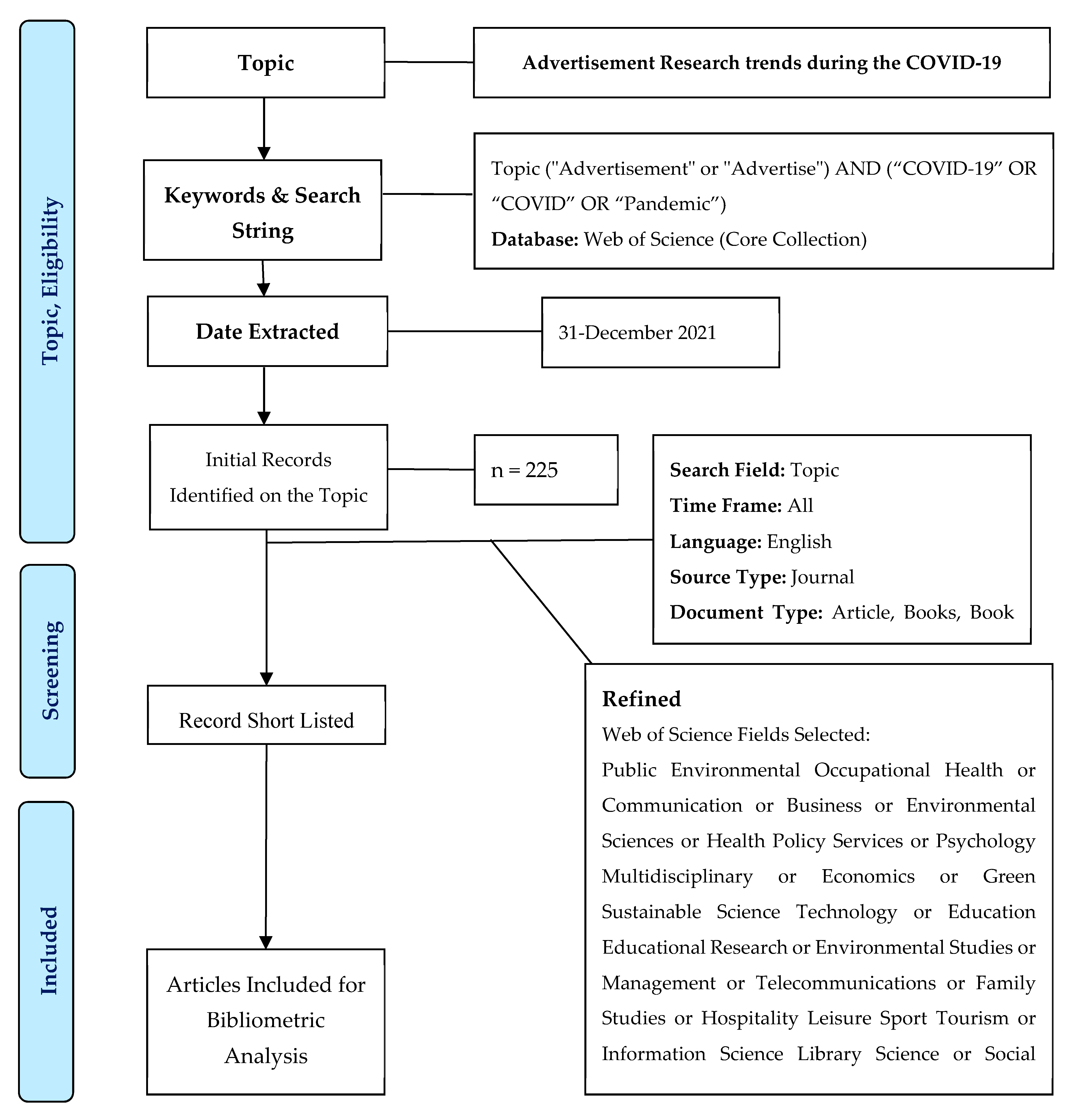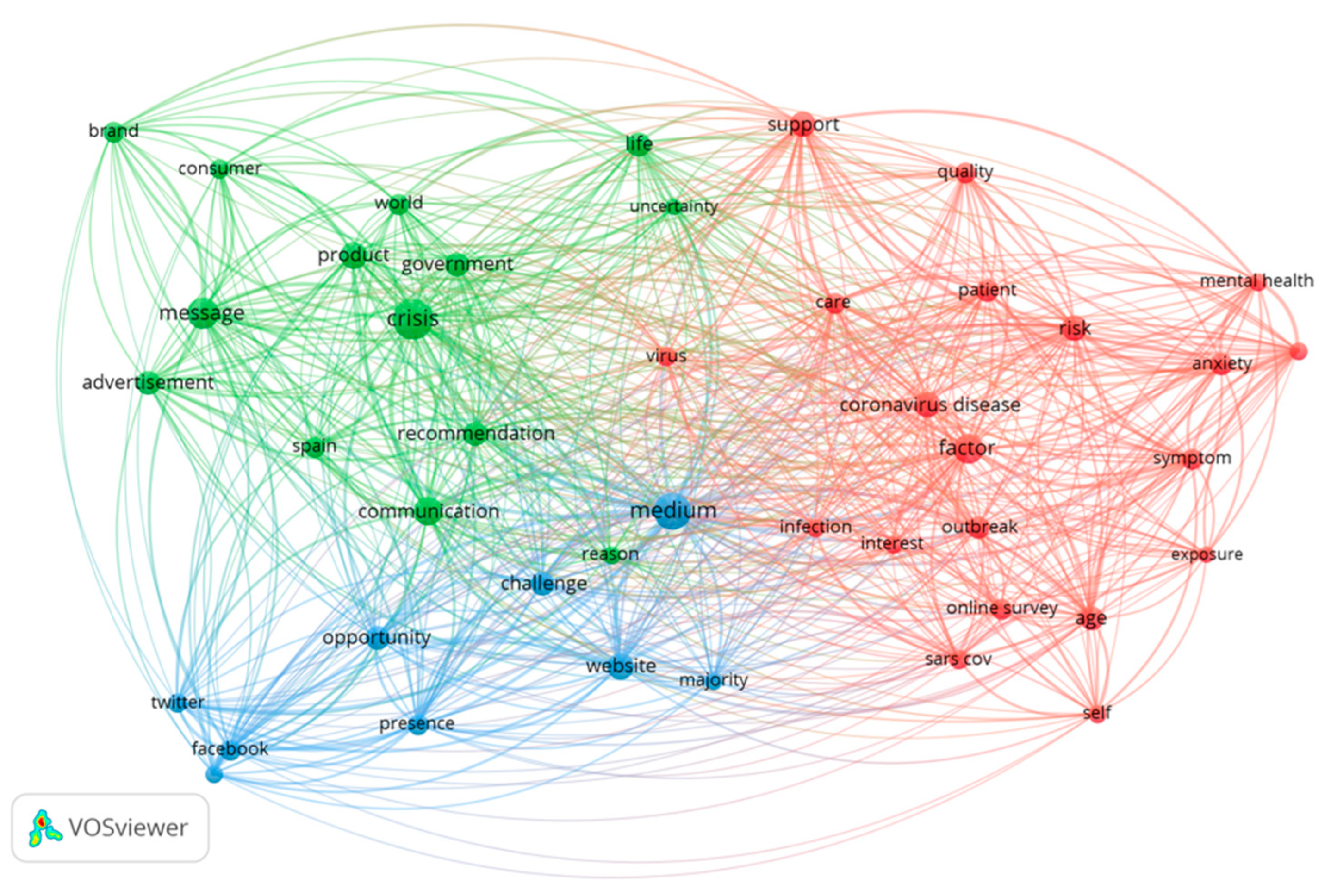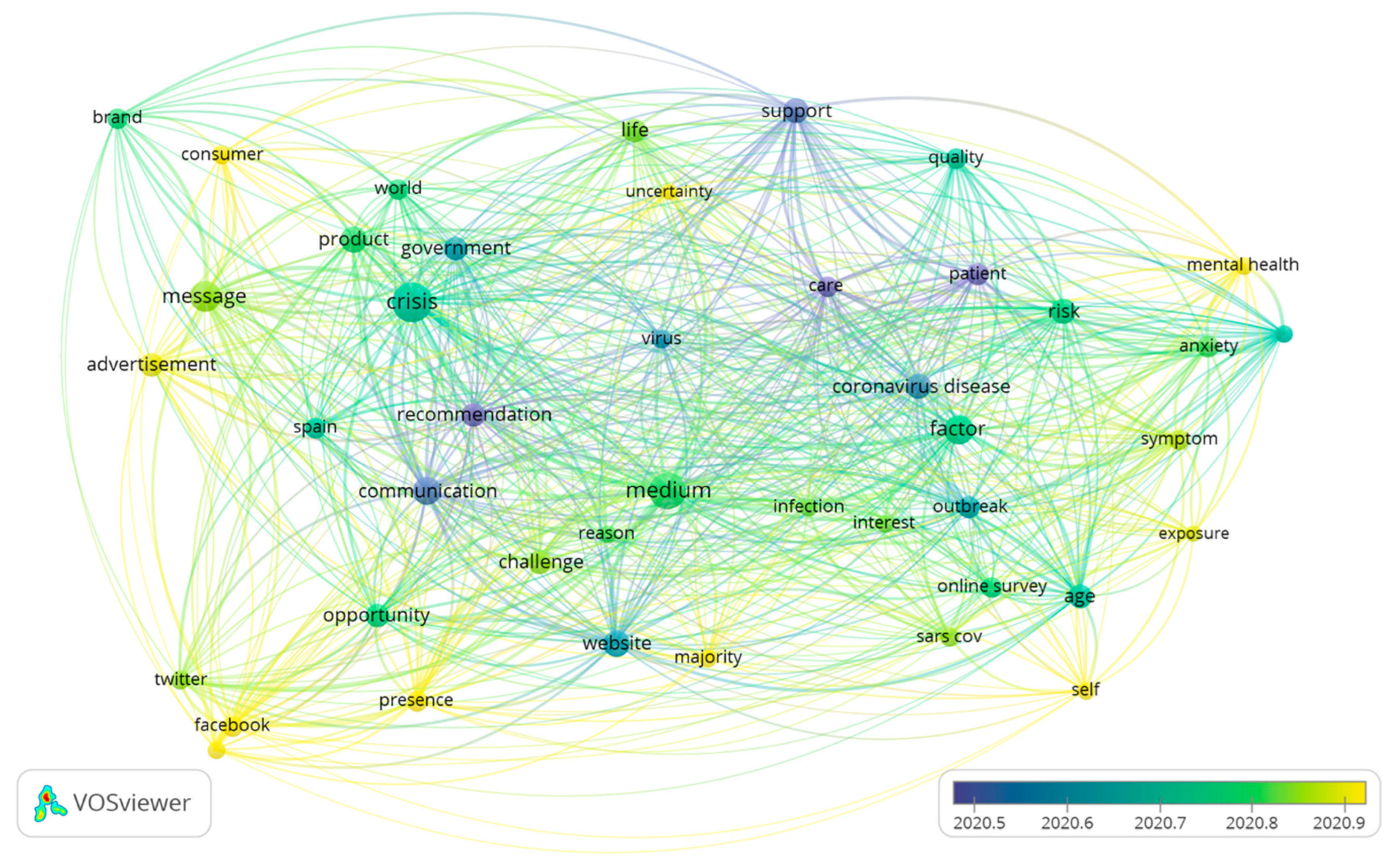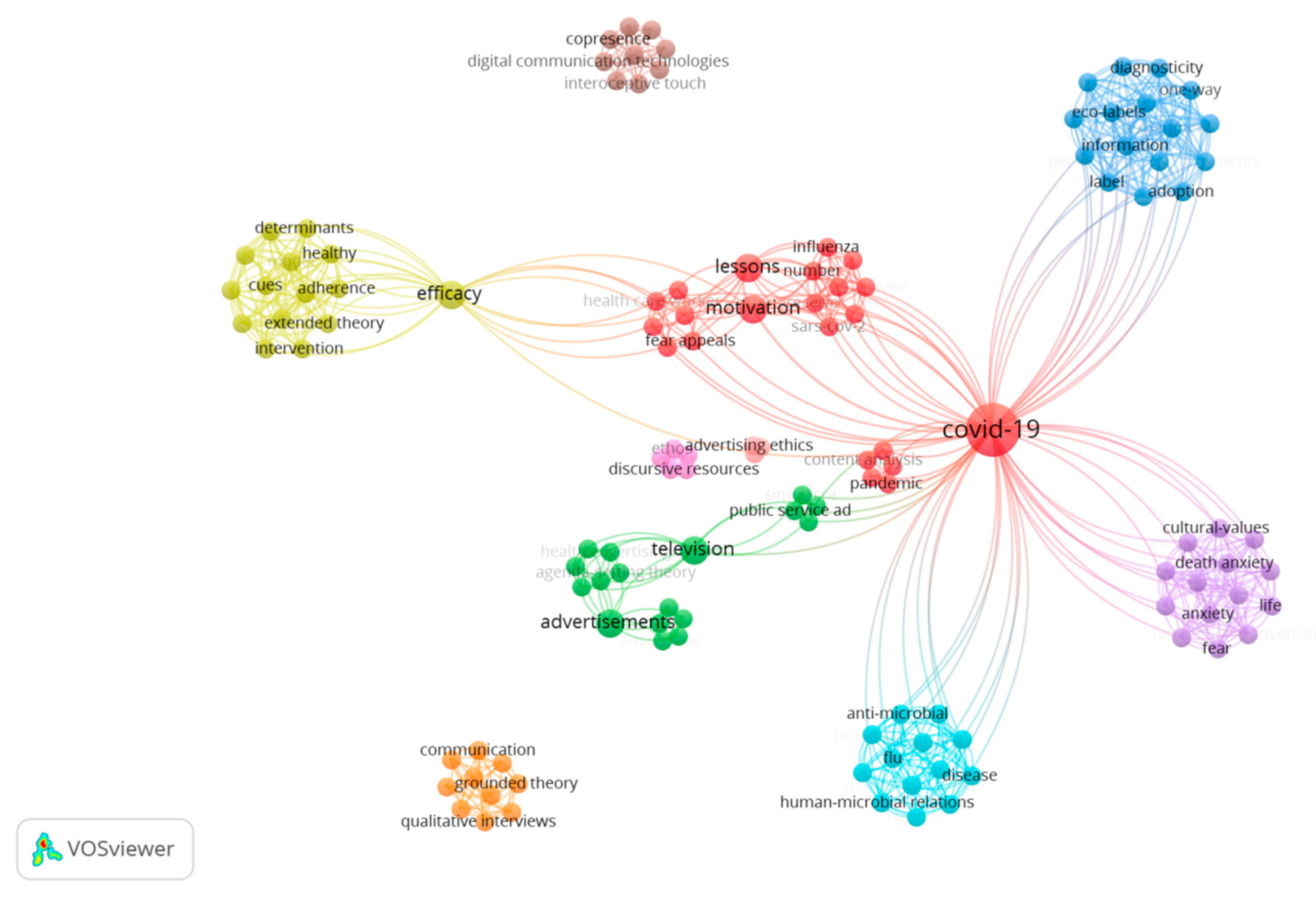Advertising during the COVID-19 Pandemic: Trends and Theoretical Developments
Abstract
1. Introduction
- RQ1. What were the leading advertising research trend clusters that emerged during the COVID-19 pandemic?
- RQ2. Which different theoretical lenses did researchers apply to conduct advertising research during the pandemic and how did they apply them?
- RQ3: What are the advertising research-related lessons that the pandemic can provide practitioners/advertising managers?
- RQ4: What are the future research opportunities in the area of pandemic-related advertising research?
2. Advertising Research during Pandemics (before COVID-19)
3. Methodology
Search Strategy
4. Results
4.1. Most-Cited Publications
4.2. Leading Journals
4.3. Thematic Clusters via Text Mining
4.4. Theoretical Clusters
- Cluster 1: Protection Motivation Theory
- Cluster 2: Agenda Setting Theory
- Cluster 3: Terror Management Theory
- Cluster 4: Grounded Theory
- Cluster 5: Temporal Self-Regulation Theory
- Cluster 6: Theory of Planned Behavior
5. Discussion and Research Contributions
5.1. Research Contributions
5.2. Theoretical Contributions
5.3. Managerial Implications
5.4. Future Research Agenda
6. Limitations
7. Conclusions
Author Contributions
Funding
Institutional Review Board Statement
Informed Consent Statement
Data Availability Statement
Conflicts of Interest
References
- Akan, Na. 2021. Covid-19 Advertisements in Turkey: The Use of Informative and Transformational Message Strategies. Turkish Journal of Communication Studies 38: 55–72. [Google Scholar]
- Ali, Raza, Richard Lynch, T. C. Melewar, and Zhongqi Jin. 2015. The moderating influences on the relationship of corporate reputation with its antecedents and consequences: A meta-analytic review. Journal of Business Research 68: 1105–17. [Google Scholar] [CrossRef]
- Alshater, Mohammad M., Omar F. Atayah, and Adnan Khan. 2021. What do we know about business and economics research during COVID-19: A bibliometric review. Economic Research-Ekonomska Istraživanja 35: 1884–912. [Google Scholar] [CrossRef]
- Aristovnik, Aleksander, Daša Ravšelj, and Lan Umek. 2020. A bibliometric analysis of COVID-19 across science and social science research landscape. Sustainability 12: 9132. [Google Scholar] [CrossRef]
- Blanco-Herrero, Diego, Jorge Gallardo-Camacho, and Carlos Arcila-Calderón. 2021. Health Advertising during the Lockdown: A Comparative Analysis of Commercial TV in Spain. International Journal of Environmental Research and Public Health 18: 1054. [Google Scholar] [CrossRef]
- Bush, Alan J., and Gregory W. Boller. 1991. Rethinking the role of television advertising during health crises: A rhetorical analysis of the federal AIDS campaigns. Journal of Advertising 20: 28–37. [Google Scholar] [CrossRef]
- Chen, Yi-Lung, Yen-Ju Lin, Yu-Ping Chang, Wen-Jiun Chou, and Cheng-Fang Yen. 2021. Differences in the protection motivation theory constructs between people with various latent classes of motivation for vaccination and preventive behaviors against COVID-19 in Taiwan. International Journal of Environmental Research and Public Health 18: 7042. [Google Scholar] [CrossRef]
- Cobo, María J., Francisco Chiclana, Andy Collop, Juan de Ona, and Enrique Herrera-Viedma. 2013. A bibliometric analysis of the intelligent transportation systems research based on science mapping. IEEE Transactions on Intelligent Transportation Systems 15: 901–8. [Google Scholar] [CrossRef]
- Cruz-Cárdenas, Jesús, Ekaterina Zabelina, Javier Guadalupe-Lanas, Ana Palacio-Fierro, and Carlos Ramos-Galarza. 2021. COVID-19, consumer behavior, technology, and society: A literature review and bibliometric analysis. Technological Forecasting and Social Change 173: 121179. [Google Scholar] [CrossRef]
- Dai, Yue, Yimin Li, Cheng-Yi Cheng, Han Zhao, and Ting Meng. 2021. Government-Led or Public-Led? Chinese Policy Agenda Setting during the COVID-19 Pandemic. Journal of Comparative Policy Analysis: Research and Practice 23: 157–75. [Google Scholar] [CrossRef]
- Demsar, Vilma, Sean Sands, Colin Campbell, and Leyland Pitt. 2021. “Unprecedented”, “extraordinary”, and “we’re all in this together”: Does advertising really need to be so tedious in challenging times? Business Horizons 64: 415–24. [Google Scholar] [CrossRef]
- Deng, Tao, Daradirek Ekachai, and James Pokrywczynski. 2022. Global COVID-19 advertisements: Use of informational, transformational and narrative advertising strategies. Health Communication 37: 628–36. [Google Scholar] [CrossRef] [PubMed]
- Deveci, A., and A. A. Cesur. 2021. Your doctor speaking: The representation of doctor characters in COVID-19 public service advertisements. Turkiye Iletisim Arastirmalari Dergisi-Turkish Review of Communication Studies 37: 254–73. [Google Scholar]
- Evans, Rhoda, Paul Norman, and Thomas L. Webb. 2017. Using Temporal Self-Regulation Theory to understand healthy and unhealthy eating intentions and behaviour. Appetite 116: 357–64. [Google Scholar] [CrossRef]
- Ezati Rad, Reza, Saber Mohseni, Hassan Kamalzadeh Takhti, Mohsen Hassani Azad, Nahid Shahabi, Teamur Aghamolaei, and Fatemeh Norozian. 2021. Application of the protection motivation theory for predicting COVID-19 preventive behaviors in Hormozgan, Iran: A cross-sectional study. BMC Public Health 21: 466. [Google Scholar] [CrossRef]
- Feres, B. D., Patrícia Ferreira Neves Ribeiro, and Rosane Santos Mauro Monnerat. 2021. Faces, Affections and Intentionality: Semiolinguistic Analysis of Pandemic Brands. Linha D Agua 34: 60–80. [Google Scholar] [CrossRef]
- Garaus, Marion, and Christian Garaus. 2021. The Impact of the Covid-19 Pandemic on Consumers’ Intention to Use Shared-Mobility Services in German Cities. Frontiers in Psychology 12: 646593. [Google Scholar] [CrossRef]
- Glaser, Barney G., and Anselm L. Strauss. 1967. The discovery of grounded theory. In Strategies for Qualitative Research. Hawthorne: Aldine Publishing Company. [Google Scholar]
- Godinho, Carlos A., Lucy Yardley, Afrodita Marcu, Fiona Mowbray, Emma Beard, and Susan Michie. 2016. Increasing the intent to receive a pandemic influenza vaccination: Testing the impact of theory-based messages. Preventive Medicine 89: 104–11. [Google Scholar] [CrossRef]
- Greenberg, Jeff, Tom Pyszczynski, and Sheldon Solomon. 1986. The causes and consequences of a need for self-esteem: A terror management theory. In Public Self and Private Self. New York: Springer, pp. 189–212. [Google Scholar]
- Hall, Peter A., and Geoffrey T. Fong. 2007. Temporal self-regulation theory: A model for individual health behavior. Health Psychology Review 1: 6–52. [Google Scholar] [CrossRef]
- Jiménez-Sánchez, Margalina Ángel, M. Verónica, and Eugenio Vayas-Ruiz. 2020. Governmental communication and brand advertising during the COVID-19 pandemic. Tripodos 2: 29–46. [Google Scholar] [CrossRef]
- Jones, Sandra C., Louise Waters, Owen Holland, John Bevins, and Don Iverson. 2010. Developing pandemic communication strategies: Preparation without panic. Journal of Business Research 63: 126–32. [Google Scholar] [CrossRef]
- Ko, Nai-Ying, Wei-Hsin Lu, Yi-Lin Chen, Dong-Jing Li, Yu-Ping Chang, Po-Wen Wang, and Cheng-Fang Yen. 2020a. Cognitive, Affective, and Behavioral Constructs of COVID-19 Health Beliefs: A Comparison Between Sexual Minority and Heterosexual Individuals in Taiwan. International Journal of Environmental Research and Public Health 17: 4282. [Google Scholar] [CrossRef] [PubMed]
- Ko, Nai-Ying, Wei-Hsin Lu, Yi-Lung Chen, Dian-Jeng Li, Yu-Ping Chang, Chia-Fen Wu, Peng-Wei Wang, and Cheng-Fang Yen. 2020b. Changes in Sex Life among People in Taiwan during the COVID-19 Pandemic: The Roles of Risk Perception, General Anxiety, and Demographic Characteristics. International Journal of Environmental Research and Public Health 17: 5822. [Google Scholar] [CrossRef] [PubMed]
- Li, Dian-Jeng, Nai-Ying Ko, Ying-Ling Chen, Peng-Wei Wang, Yu-Ping Chang, Cheng-Fang Yen, and Wu-Huei Lu. 2020. COVID-19-Related Factors Associated with Sleep Disturbance and Suicidal Thoughts among the Taiwanese Public: A Facebook Survey. International Journal of Environmental Research and Public Health 17: 4479. [Google Scholar] [CrossRef] [PubMed]
- Liddelow, Christobel, Alan Ferrier, and Barbara Mullan. 2021. Understanding the predictors of hand hygiene using aspects of the theory of planned behaviour and temporal self-regulation theory. Psychology & Health 38: 555–72. [Google Scholar] [CrossRef]
- Lin, Yen-Ju, Cheng-Fang Yen, Yu-Ping Chang, and Peng-Wei Wang. 2021. Comparisons of motivation to receive COVID-19 vaccination and related factors between frontline physicians and nurses and the public in Taiwan: Applying the extended protection motivation theory. Vaccines 9: 528. [Google Scholar] [CrossRef]
- Mason, Andrew N., John Narcum, and Karen Mason. 2021. Social media marketing gains importance after COVID-19. Cogent Business & Management 8: 1870797. [Google Scholar]
- McLeod, Carmen, Eleanor Hadley Kershaw, and Brigitte Nerlich. 2020. Fearful intimacies: COVID-19 and the reshaping of human-microbial relations. Anthropology in Action 27: 33–39. [Google Scholar] [CrossRef]
- Minton, Elizabeth A., Hyejin Park, and Nathaniel Spielmann. 2022. Death primes in advertisements: How international advertisers can ensure their message is effective. International Journal of Advertising 41: 1143–77. [Google Scholar] [CrossRef]
- News Media Association. 2020. Government Partners with Newspaper Industry on COVID-19 Ad Campaign. Available online: http://www.newsmediauk.org/Latest/government-partners-with-newspaper-industry-on-covid-19-ad-campaign (accessed on 17 January 2021).
- Öztürk, Rüstem. 2020. The trends of marketing literature during the COVID-19 pandemic: A review with bibliometric analysis. OPUS Uluslararası Toplum Araştırmaları Dergisi 16: 3251–73. [Google Scholar]
- Park, Jooyoung, Jungkeun Kim, Daniel C. Lee, Seongseop S. Kim, Benjamin G. Voyer, Changju Kim, Billy Sung, Hector Gonzalez-Jimenez, Fernando Fastoso, Yung K. Choi, and et al. 2022. The impact of COVID-19 on consumer evaluation of authentic advertising messages. Psychology & Marketing 39: 76–89. [Google Scholar]
- Petrovici, Iasmina, Simona Bader, and Corina Sirb. 2020. Social Responsibility in Romanian Advertising during State of Emergency. Postmodern Openings 11: 366–80. [Google Scholar] [CrossRef]
- Pyszczynski, Tom, Milena Lockett, Jeff Greenberg, and Sheldon Solomon. 2020. Terror Management Theory and the COVID-19 Pandemic. Journal of Humanistic Psychology 61: 173–89. [Google Scholar] [CrossRef]
- Raymond, Melissa A., John F. Tanner, and David R. Eppright. 1998. The AIDS pandemic: Changes in the believability and use of information sources. Health Marketing Quarterly 15: 1–24. [Google Scholar] [CrossRef]
- Rousseau, Denise M. 2006. Is there such a thing as “evidence-based management”? Academy of Management Review 31: 256–69. [Google Scholar] [CrossRef]
- Rybak, Garrett, Scot Burton, Andrew M. Johnson, and Chad Berry. 2021. Promoted claims on food product packaging: Comparing direct and indirect effects of processing and nutrient content claims. Journal of Business Research 135: 464–79. [Google Scholar] [CrossRef]
- Saunders, Mark N., and Céline Rojon. 2011. On the attributes of a critical literature review. Coaching: An International Journal of Theory, Research and Practice 4: 156–62. [Google Scholar] [CrossRef]
- Seyedabolghasemi, Mir Amir, Hasan Kilic, Turgut Avci, Kayode Kazeem Eluwole, and Tunde Tijani Lasisi. 2022. Residents’ perceptions of sustainable tourism destination recovery: The case of Northern Cyprus. Land 11: 94. [Google Scholar] [CrossRef]
- Sheng, Xiaoyang, Scott C. Ketron, and Yuanyuan Wan. 2022. Identifying consumer segments based on COVID-19 pandemic perceptions and responses. Journal of Consumer Affairs 56: 34–67. [Google Scholar] [CrossRef]
- Shoenberger, Hannah, Eunjin Kim, and Yiru Sun. 2021. Advertising during COVID-19: Exploring perceived brand message authenticity and potential psychological reactance. Journal of Advertising 50: 253–61. [Google Scholar] [CrossRef]
- Tunner, John F., Jr., Ellen Day, and Melvin R. Crask. 1989. Protection motivation theory: An extension of fear appeals theory in communication. Journal of Business Research 19: 267–76. [Google Scholar] [CrossRef]
- Utkarsh, and Marianna Sigala. 2021. A bibliometric review of research on COVID-19 and tourism: Reflections for moving forward. Tourism Management Perspectives 40: 100912. [Google Scholar] [CrossRef] [PubMed]
- Van Esch, Pieter, Yu Cui, and Saurabh Prasad Jain. 2021. COVID-19 Charity Advertising: Identifiable victim message framing, self-construal, and donation intent. Journal of Advertising 50: 290–98. [Google Scholar] [CrossRef]
- Verma, Shashi, and Anders Gustafsson. 2020. Investigating the emerging COVID-19 research trends in the field of business and management: A bibliometric analysis approach. Journal of Business Research 118: 253–61. [Google Scholar] [CrossRef] [PubMed]
- Vorhaus, Mike. 2020. COVID-19 Represents the Biggest Challenge to Media Advertising Expenditures Ever. Forbes.com, April 27. Available online: https://www.forbes.com/sites/mikevorhaus/2020/04/27/covid-19-represents-the-biggest-challenge-to-media-advertising-expenditures-ever/#5b207e357398 (accessed on 12 February 2021).
- World Health Organization (WHO). 2022. WHO Coronavirus (COVID-d). Available online: https://covid19.who.int/ (accessed on 14 February 2022).
- Zhou, Shuguang, Zexuan Tao, Yong Zhu, and Lian Tao. 2019. Mapping theme trends and recognizing hot spots in postmenopausal osteoporosis research: A bibliometric analysis. PeerJ 7: e8145. [Google Scholar] [CrossRef]
- Zupic, Irena, and Tina Čater. 2015. Bibliometric Methods in Management and Organization. Organizational Research Methods 18: 429–72. [Google Scholar] [CrossRef]




| Title(s) | First Author (year) | TLS | TC | Avg. Norm Citation |
|---|---|---|---|---|
| Changes in Sex Life Among People in Taiwan During the COVID-19 Pandemic: The Roles of Risk Perception, General Anxiety, and Demographic Characteristics | Ko et al. (2020b) | 17 | 15 | 1.77 |
| Cognitive, Affective, And Behavioral Constructs of COVID-19 Health Beliefs: A Comparison Between Sexual Minority and Heterosexual Individuals in Taiwan | Ko et al. (2020a) | 14 | 14 | 1.65 |
| COVID-19-Related Factors Associated with Sleep Disturbance and Suicidal Thoughts Among the Taiwanese Public: A Facebook Survey | Li et al. (2020) | 10 | 43 | 5.07 |
| How to Improve Compliance with Protective Health Measures During the COVID-19 Outbreak: Testing A Moderated Mediation Model and Machine Learning Algorithms | Roma (2020) | 7 | 43 | 5.07 |
| Reduced Level of Physical Activity During COVID-19 Pandemic Is Associated with Depression and Anxiety Levels: An Internet-Based Survey | Puccinelli (2021) | 6 | 21 | 7.00 |
| Health Care Workers’ Mental Health and Quality of Life During COVID-19: Results from A Mid-Pandemic, National Survey | Young (2021) | 4 | 21 | 7.00 |
| Trends and Predictors of COVID-19 Information Sources and Their Relationship with Knowledge and Beliefs Related to the Pandemic: Nationwide Cross-Sectional Study | Ali (2020) | 4 | 41 | 4.83 |
| Sex in the Time of COVID-19: Results of An Online Survey of Gay, Bisexual and Other Men Who Have Sex with Men’s Experience of Sex and HIV Prevention During the Us COVID-19 Epidemic | Stephenson (2021) | 3 | 45 | 15.00 |
| Mental Health Needs Among Lesbian, Gay, Bisexual, And Transgender College Students During the COVID-19 Pandemic | Gonzales (2020) | 3 | 50 | 5.89 |
| Nudging to Reduce the Perceived Threat of Coronavirus | Kim (2020) | 3 | 21 | 2.47 |
| Online Social Endorsement and COVID-19 Vaccine Hesitancy in the United Kingdom | Chadwick (2021) | 1 | 12 | 4.00 |
| Exposure to Health Misinformation About COVID-19 and Increased Tobacco and Alcohol Use: A Population-Based Survey in Hong Kong | Luk (2021) | 1 | 10 | 3.33 |
| Business-To-Business Marketing Responses to COVID-19 Crisis: A Business Process Perspective | Kang (2021) | 1 | 10 | 3.33 |
| Regulation of COVID-19 Fake News Infodemic In China and India | Rodrigues (2020) | 1 | 12 | 1.41 |
| Journals | Documents | Citations | Norm. Citations | Avg. Citations | Avg. Norm. Citations |
|---|---|---|---|---|---|
| International Journal of Environmental Research and Public Health | 21 | 170 | 26.93 | 8.10 | 1.28 |
| Journal of Advertising | 12 | 30 | 5.47 | 2.50 | 0.46 |
| Sustainability | 7 | 3 | 0.78 | 0.43 | 0.11 |
| BMC Public Health | 3 | 27 | 9.00 | 9.00 | 3.00 |
| Research in Social & Administrative Pharmacy (RSAP) | 3 | 10 | 3.33 | 3.33 | 1.11 |
| Profesional De La Informacion | 3 | 7 | 1.04 | 2.33 | 0.35 |
| Tripodos | 3 | 4 | 0.47 | 1.33 | 0.16 |
| Journal of Adolescent Health | 2 | 52 | 6.56 | 26.00 | 3.28 |
| Social Media + Society | 2 | 12 | 4.00 | 6.00 | 2.00 |
| Tobacco Control | 2 | 10 | 3.33 | 5.00 | 1.67 |
| Journal of Business Research | 2 | 41 | 2.93 | 20.50 | 1.46 |
| Media International Australia | 2 | 14 | 2.08 | 7.00 | 1.04 |
| International Journal for Equity in Health | 2 | 5 | 1.67 | 2.50 | 0.83 |
| Public Health | 2 | 15 | 1.13 | 7.50 | 0.57 |
| Digital Journalism | 2 | 2 | 0.67 | 1.00 | 0.33 |
| C1—Public Health | C2—Crisis Information and Stakeholders | C3—Communication Channels |
|---|---|---|
| Age | Advertisement | Communication |
| Anxiety | Brand | |
| Care | Consumer | |
| Depression | Crisis | Medium |
| Exposure | Government | Opportunity |
| Infection | Importance | Presence |
| Life | Message | |
| Mental health | Product | |
| Outbreak | Reason | |
| Patient | Recommendation | |
| Quality | Spread | |
| Risk | Uncertainty | |
| Support | Virus | |
| Symptom |
| Cluster 1 | Cluster 2 | Cluster 3 | Cluster 4 | Cluster 5 |
|---|---|---|---|---|
| COVID-19 | Advertisements | Anxiety | Communication | Adherence |
| Digital advertisement | Advertising | Cultural values | Grounded theory | Determinants |
| Fear appeals | Agenda setting theory | Death anxiety | Management | Efficacy |
| Health care worker | Cause-related marketing | Fear | Qualitative interviews | Extended theory |
| Intentions | COVID-19 pandemic | International advertising | Resident perceptions | Habit |
| Lessons | Health advertising | Life | Stakeholder engagement | Hand hygiene |
| Pandemic | Health communication | Materialism | Stakeholders | Healthy |
| Prevention behavior | Lockdown | Mortality silence | Sustainable tourism development | Intentions |
| Protection motivation theory (PMT) | Public service advertisement | Religion | Tourism recovery | Temporal self-regulation theory |
| Reliability | Simulacra | Self-esteem | Theory of planned behavior | |
| Sars-CoV-2 | Simulation | Terror management | ||
| Taylor’s six-segment message strategy wheel | Social responsibility | Terror management theory | ||
| Vaccination | Speech acts | Worldwide defense | ||
| Vaccine | Television | |||
| Visual communication |
| First Author (Year) | Title | Theoretical Lens Applied |
|---|---|---|
| Akan (2021) | COVID-19 advertisements in Turkey: Use of informational and transformational message strategies | Taylor’s six-segment message strategy wheel and narrative transportation theory |
| Blanco-Herrero et al. (2021) | Health advertising during the lockdown: a comparative analysis of commercial TV in Spain | Agenda setting theory |
| Garrett Rybak et al. (2021) | How restaurant protective ad messaging can increase patronage intentions during the COVID-19 pandemic: conditional serial mediation and COVID-19 consumer concern | Persuasion theory |
| Minton et al. (2022) | Death primes in advertisements: How international advertisers can ensure their message is effective | Terror management theory |
| Deveci and Cesur (2021) | Your doctor speaking: The representation of doctor characters in COVID-19 public service advertisements | Jean Baudrillard’s simulation theory |
| Seyedabolghasemi et al. (2022) | Residents’ perceptions of sustainable tourism destination recovery: The case of Northern Cyprus | Grounded theory |
| Lin et al. (2021) | Comparisons of motivation to receive COVID-19 vaccination and related factors between frontline physicians and nurses and the public in Taiwan: Applying the extended protection motivation theory | Extended protection motivation theory |
| Deng et al. (2022) | Global COVID-19 advertisements: Use of informational, transformational, and narrative advertising strategies | Taylor’s six-segment message strategy wheel and narrative transportation theory |
| Mcleod et al. (2020) | Fearful intimacies COVID-19 and the reshaping of human-microbial relations | Germ theory |
| Petrovici et al. (2020) | Social responsibility in Romanian advertising during a state of emergency | Speech acts theory |
| Chen et al. (2021) | Differences in the protection motivation theory constructs between people with various latent classes of motivation for vaccination and preventive behaviors against COVID-19 in Taiwan | Protection motivation theory |
| Liddelow et al. (2021) | Understanding the predictors of hand hygiene using aspects of the theory of planned behaviour and temporal self-regulation theory | Theory of planned behaviour and temporal self-regulation theory |
| Feres et al. (2021) | Faces, affections and intentionality: Semiolinguistic analysis of pandemic brands | Semiolinguistic theory of discourse analysis |
| Garaus and Garaus (2021) | The impact of the COVID-19 pandemic on consumers’ intention to use shared-mobility services in German cities | Signaling theory |
Disclaimer/Publisher’s Note: The statements, opinions and data contained in all publications are solely those of the individual author(s) and contributor(s) and not of MDPI and/or the editor(s). MDPI and/or the editor(s) disclaim responsibility for any injury to people or property resulting from any ideas, methods, instructions or products referred to in the content. |
© 2023 by the authors. Licensee MDPI, Basel, Switzerland. This article is an open access article distributed under the terms and conditions of the Creative Commons Attribution (CC BY) license (https://creativecommons.org/licenses/by/4.0/).
Share and Cite
Najam, U.; Ali, R.; Burki, U. Advertising during the COVID-19 Pandemic: Trends and Theoretical Developments. Adm. Sci. 2023, 13, 170. https://doi.org/10.3390/admsci13070170
Najam U, Ali R, Burki U. Advertising during the COVID-19 Pandemic: Trends and Theoretical Developments. Administrative Sciences. 2023; 13(7):170. https://doi.org/10.3390/admsci13070170
Chicago/Turabian StyleNajam, Usama, Raza Ali, and Umar Burki. 2023. "Advertising during the COVID-19 Pandemic: Trends and Theoretical Developments" Administrative Sciences 13, no. 7: 170. https://doi.org/10.3390/admsci13070170
APA StyleNajam, U., Ali, R., & Burki, U. (2023). Advertising during the COVID-19 Pandemic: Trends and Theoretical Developments. Administrative Sciences, 13(7), 170. https://doi.org/10.3390/admsci13070170






